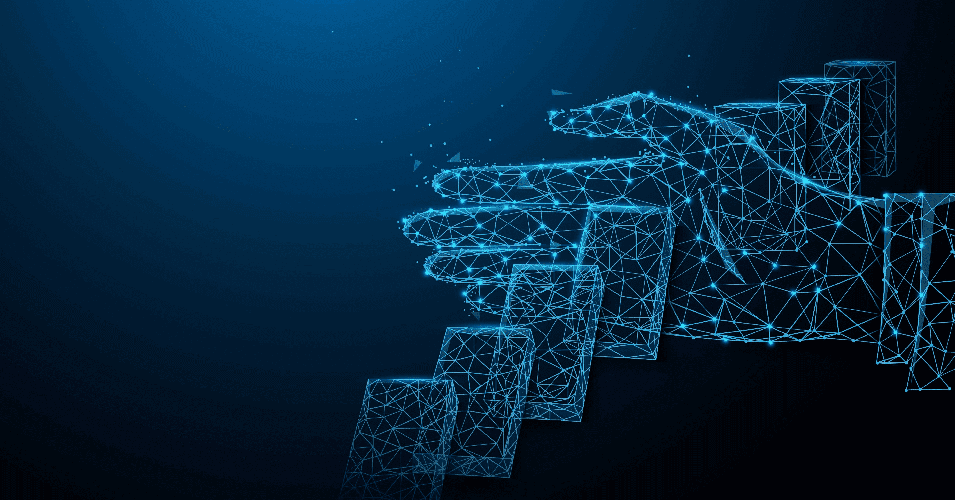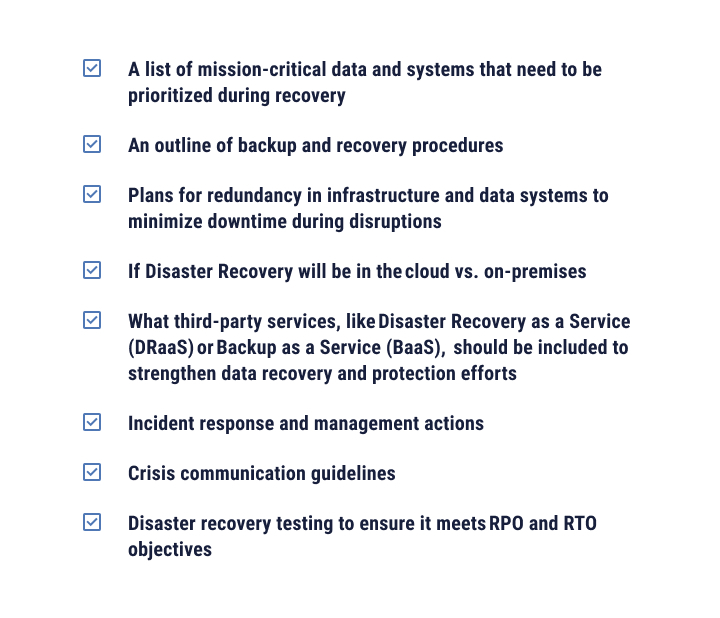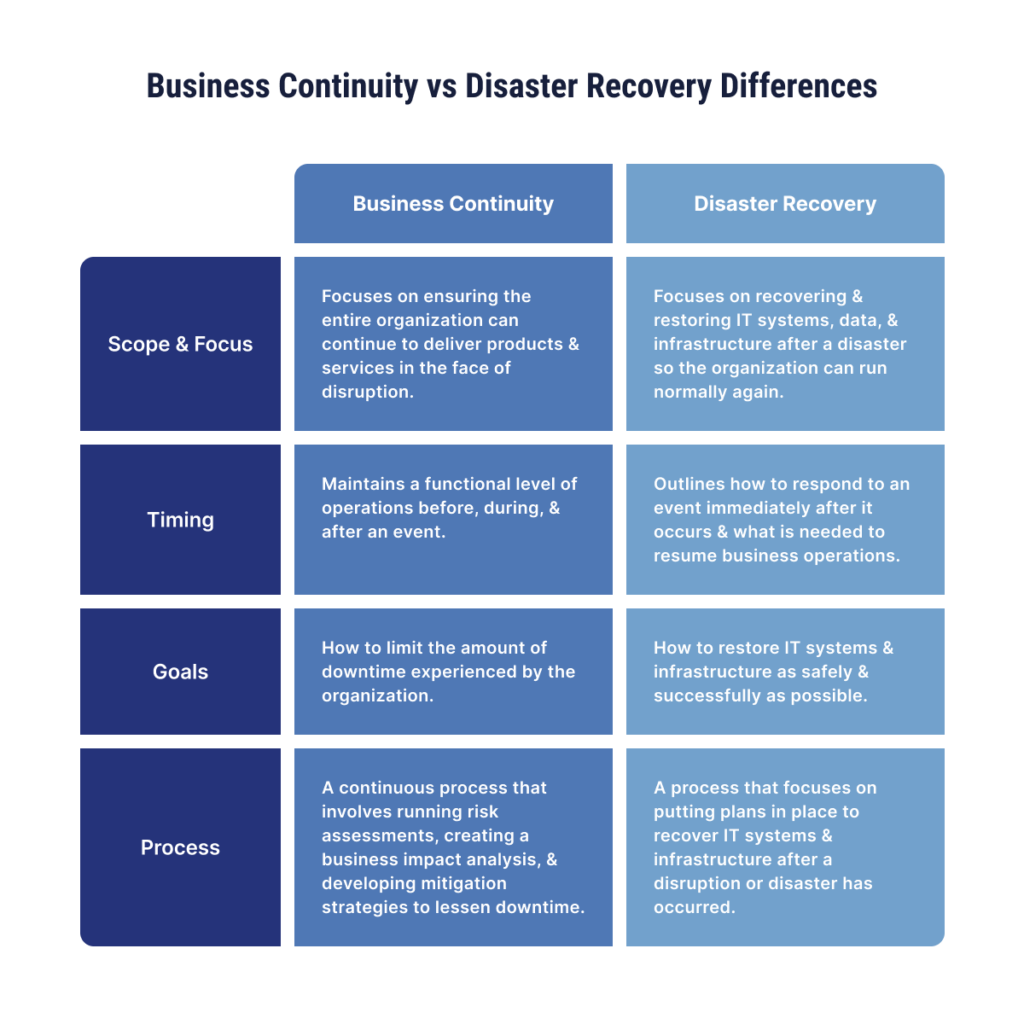February 14, 2024 | Channing Lovett
Business Continuity vs Disaster Recovery: What’s the Difference?

When deciding how to prepare for and operate during and after disruptions, there are two important concepts to study: business continuity (BC) and disaster recovery (DR).
Unfortunately, disasters happen. Cyberattacks have held the top spot for the most common and most impactful causes of business outages across organizations for the fourth straight year, according to Veeam’s 2024 Data Protection Trends Report. These results can be catastrophic for organizations that don’t have the proper plans in place. One of the most critical duties of any IT leader is to understand and prepare for business interruptions by developing strategies, plans, and procedures to keep the business afloat if (and when) a disaster takes place.
What is Business Continuity?
Business continuity is a proactive approach to ensure a company’s critical functions can continue to operate during a natural disaster, crisis, or other disruption. These plans involve identifying potential risks, like wildfires, floods, cyber-attacks, or even supply chain issues, and developing procedures that can help mitigate risks and maintain business-as-usual operations.
Business continuity planning is an essential puzzle piece in risk management and allows organizations to adapt, and even thrive while navigating unexpected events.
What to Include in a Business Continuity Plan
A business continuity plan (BCP) should address the overall protection and response to disasters. It typically includes measures to protect critical data and infrastructure (including IT systems, processes, people, and facilities), maintain communication with stakeholders and authorities, and resume normal business operations as quickly as possible. Some elements to consider incorporating into your BCP include:
- A Critical Function and Business Impact Analysis: Write down and analyze the critical functions needed for your business to continue operating. Estimate how your business will be impacted if any mission-critical functions or infrastructure goes down.
- A Threat Assessment: Develop a list of all potential risks that could threaten your business and result in severe disruptions. Categorize threat levels by examining risk tolerances and risk appetite so you can better understand which fall outside of the acceptable range.
- A Strategy List: Create a detailed list of the strategies and mitigation activities you can launch that will protect your mission-critical functions from the potential threats that were previously identified and analyzed. This should also include a plan for continuing operations in an alternate workspace if the primary location is impacted by an unplanned disruption.
- Important Contacts and Communication Guidelines: Document key points of contact (as well as assign a second-in-command if the primary person is unavailable) who will handle disruptive events and ensure all employees have access to their information. Additionally, set guidelines around how employees can communicate with internal staff, external suppliers, partners, government authorities, customers, and any other stakeholders if systems go down during an event.
- Scheduled Testing and Documentation: Regularly test different types of scenarios to ensure your strategies work and you’re able to maintain (or quickly bring back) core business functions. Carefully document each test and analyze it against key metrics and indicators to see if there’s a need for any adjustments.
What is Disaster Recovery?
While business continuity focuses on mitigating risks and keeping organizations running during a disaster, think of disaster recovery as a major pillar that revolves around:
- Maintaining data resiliency and safely recovering data after a disruptive event
- Minimizing downtime and data loss
- Restoring critical IT infrastructure and business operations as quickly as possible after a disaster strikes
What to Include in a Disaster Recovery Plan
When building out a Disaster Recovery plan, it’s important to create and follow a specific checklist to ensure you take an organized, detailed approach to protect and restore your organization’s important functions. Some of the components you should include within your DR plan include:
- A list of mission-critical data and systems that need to be prioritized during recovery
- An outline of backup and recovery procedures
- Plans for redundancy in infrastructure and data systems to minimize downtime during disruptions
- If Disaster Recovery will be in the cloud vs. on-premises
- What third-party services, like Disaster Recovery as a Service (DRaaS) or Backup as a Service (BaaS) should be included to strengthen data recovery and protection efforts
- Incident response and management actions
- Crisis communication guidelines
- Disaster recovery testing to ensure it meets RPO and RTO objectives

Keep in mind that these are just a few elements to include. For a more detailed list, read through TierPoint’s Disaster Recovery plan checklist here.
4 Key Differences Between Business Continuity vs Disaster Recovery
When comparing business continuity vs disaster recovery, there are some key distinctions between the two.

What an organization decides to prioritize or focus on will depend on the nature of the business and what is likely to minimize disruption and support key processes. For example, businesses that rely heavily on technology may want to prioritize disaster recovery planning, but business continuity planning may be more important for companies that depend on supply chain management.
Scope and Focus
BCP is a broader approach that encompasses the entire organization and focuses on ensuring the organization can continue to deliver products and services in the face of any disruption or disaster. Disaster Recovery, on the other hand, is more narrowly focused on recovering and restoring IT systems, data and infrastructure after a disaster, ensuring the organization can get back to running normally. Business continuity planning is well-suited for ensuring the continuity of the supply chain, especially when businesses are reliant on specific suppliers or require timely deliveries, with and without specific disasters and disruptions.
Timing
One of the main differences between Business Continuity and Disaster Recovery is timing – when is the plan activated? BC focuses on maintaining a functional level of operations before and during an event and, ideally, immediately after. DR outlines how to respond immediately after the disaster has occurred and what needs to be done to resume business-as-usual operations.
Goals
Ultimately, each process has different goals. The goal of Business Continuity planning is to outline how to limit downtime while DR plans focus on restoring IT systems and infrastructure as safely and successfully as possible to shorten downtime, stop insufficient system functions, and minimize data loss.
Process
BCP is a continuous process that involves running risk assessments, creating business impact analysis, and developing mitigation strategies to lessen downtime while DR focuses on preparing how to recover IT systems and infrastructure after a disaster has taken place.
Business Continuity vs Disaster Recovery: Does Your Organization Need Both?
In short: Yes.
Typically, DR is a subset of BC. It’s not highly important, but crucial for organizations to have both BC and DR plans in place. While they have different focuses and goals, they complement each other and are both critical for ensuring that you can confidently respond to and recover from a disaster or disruption.
Business continuity addresses the “during” state of a disruption, while disaster recovery takes care of the “after.” During a crisis, BC plans can keep vital operations moving, whereas DR works to quickly recover data and infrastructure after a crisis has ended. Broader disruptions, including supply chain issues and power outages, can be covered by a BC plan, whereas a DR plan is more focused on catastrophic events, such as cyberattacks and fires.
Having both business continuity and disaster recovery plans in place offer a more holistic approach to maximizing uptime and minimizing the impact of any and all downtime. DR plans can also be more specific, but they do often employ BC strategies in their approach, including data backups.
Combining BC and DR plans can ensure peace of mind and a sense of stability during stressful events and sets necessary safeguards against critical data loss and major interruptions.
7 Risks of Not Having a Business Continuity or Disaster Recovery Plan
There are many risks associated with not having a comprehensive BC and/or DR plan in place, such as:
Increased Threats to Business Operations
Not outlining and understanding how threats and risks can affect your business can be detrimental, and a lack of preparedness can cause doors to permanently close. Risk assessment and mitigation is fundamental to both BC and DR planning. The process involves identifying threats, analyzing the potential likelihood of a risk occurring and its expected impact, and prioritizing based on these factors. By knowing what might pose a risk to a business, you can apply preventative measures that may reduce the need for more advanced BC and DR measures down the road.
Loss of Revenue
Disruptions in business operations can lead to a loss of revenue, which can be particularly damaging for small businesses. A significant loss in revenue doesn’t just result in a downturn in numbers, it can also cause leadership to have to make some difficult decisions around employee offerings, staffing, service offerings, and pricing.
Damage to Brand Reputation and Loss of Competitive Advantage
An organization’s failure to respond quickly and effectively to, and during, disastrous events can hurt its reputation with customers, stakeholders, and even internal employees. Also, businesses without proper plans in place may lose their competitive advantage to competitors who boast a better level of preparedness.
Legal and Regulatory Penalties
Most companies are required by law to follow certain business continuity, compliance and regulatory guidelines. A failure to comply with legal or regulatory requirements related to BC and DR can result in fines or legal action.
Increased Recovery Time
Without a DR plan in place, an organization may take longer to recover from an interruption, which can further impact revenue and productivity. Additionally, without a BC plan, it’s difficult for IT leaders to prioritize critical functions that need to continue running in some capacity during an interruption in operations.
Increased Costs
According to IBM’s Cost of a Data Breach Report, the global average cost of a data breach in 2023 was USD 4.45 million, a 15% increase over 3 years.
While the initial cost of creating and maintaining a business continuity or disaster recovery plan might seem like an unnecessary expense, the lack of one can lead to a hidden financial storm when disaster strikes. Responding to an interruption without a plan in place can result in increased costs for:
- Repairs
- Recovery
- Remediation efforts
Data Loss
Not having a backup plan for critical data can result in permanent loss of data, which can have serious consequences for the organization. Data loss can cause things like:
- Damaged brand trust and reputation
- Loss of revenue
- Decreased productivity, especially if data must be re-created
- Legal issues
- And more
Be Proactive in Your Business Continuity and Disaster Recovery
BC and DR are crucial for any organization to survive and thrive in the face of unexpected events. By proactively identifying potential risks, developing comprehensive plans, and regularly testing and updating BC and DR plans, you can decrease downtime, protect your brand reputation, and safeguard your bottom line.
Disasters can strike at any moment and with the right preparation and DRaaS in place, you can be ready to face them head-on. Don’t wait until it’s too late – start planning today by downloading TierPoint’s Ultimate Guide to Running Your Business Through Uncertainty and Disruption to ensure the future success of your business.

